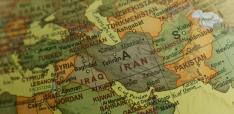What Are the Limitations of Working with the Grain?

Brian Levy responds to two recent blogs exploring his idea of 'working with the grain' to support governance and developmental reforms.
When does a call to ‘work with the grain’ violate foundational ethical commitments? Governance reversals globally have given new urgency to this question; it has recently been posed both in Oxfam’s blog and in the London School of Economics Public Authority blog series. The new year seems like a good time to share my views, in the form of five guideposts.
When I wrote Working with the Grain (WWG) in the early 2010s, my intent was to provide a road map for pragmatism. At the time, it was plausible to think that, haltingly and unevenly, the arc of the moral universe was bending towards justice. But five years later there’s no avoiding the rise of polarization, ethno-nationalism and authoritarianism. In such a time, a call to engage pragmatically with power might seem hollow – or worse. What, then, is to be done?
- Guidepost #1: Distinguish between critical junctures and the (generally long) intervals between them.
This guidepost follows directly from the logic of ‘political settlements’. As per Mushtaq Khan, a political settlement prevails where “the distribution of benefits supported by its institutions is consistent with the distribution of power in society – and the economic and political outcome of these institutions is sustainable over time. Approaches to engagement at critical junctures are thus qualitatively different from those in a time of stability. In writing WWG, my principal focus was on the latter. Hence:
- Guidepost #2: During periods of stability, anchor reform efforts within an understanding of the political and institutional incentives and constraints which prevail in a particular context.
WWG aimed to identify a variety of distinct contexts, each comprising a distinctive platform for development, with distinctive incentives for the participants, distinctive constraints and risks, and distinctive frontier challenges. Directing attention to these incentives and constraints was intended to provide a platform for identifying specific ‘good fit’ policy actions which are both worthwhile and feasible, given country-specific institutional realities.
Working along these lines is very different from ‘going with the flow’ — it is a call to work creatively within the broader prevailing policy, institutional and political realities. Thus:
- Guidepost #3: A ‘with the grain’ approach need not be timidly incremental – its aim is to encourage reflection as to the merits of a spectrum of context-specific entry points for achieving specific policy, sectoral and institutional goals.
As illustrated by the figure below (taken from WWG), in working to address some specific reform challenge there is a spectrum of options. At one end are narrowly incremental options, aligned with the existing space for reform; at the other end is the option of engaging with stakeholders to expand the space for reform. At every level of decision-making, reformers (in government, civil society, or the donor community) must clarify how to position their engagement along this spectrum. While during periods of political stability, room for maneuver generally is likely to be limited vis-à-vis reforms of a country’s core governance arrangements, at more micro-levels the scope to be pro-active in working to ease constraints potentially is larger along both trajectories.
THE SPECTRUM OF REFORM SPACE
<=========================================================================>
Adapt design to align Expand reform space with existing reform space
__________________________________________
But how to proceed when the broader political and institutional environment is itself in question? In a 2017 review of Duncan Green’s important book, How Change Happens, I distinguished between the ‘how’ and the ‘what’ of reform. The ‘how’ task was, as Duncan put it, to learn to “dance with the system”. But pre-occupation with the ‘how’, with pragmatic responses to very specific problems, ceded to ideologues of both the right and the left the terrain of broader discourse as to public purpose. In consequence:
“we lost sight of the dynamics of power – specifically of the power of political parties to mobilize on the basis of ideas and incentives which we easily dismissed as reactionary. In so doing, we ceded the terrain of contestation over the largest political prize of all — control over state institutions – to actors and ideas which we presumed had been consigned to the dustbin of history. ….And then, one bleak morning after another, we awoke to discover that the terrain had shifted radically, that control over state institutions was shifting, and that our hard-won incremental gains risked being washed away by tidal waves of reaction…..Today’s times require heightened attention to the vision towards which change efforts are directed; we need a new balance between the ‘what’ and the ‘how’”. Hence:
- Guidepost #4: Context – time as well as place — shapes whether or not a ‘with the grain’ approach is a useful way forward.
In some times and places, reform might focus most effectively on modest incremental changes; in others, there might be scope for expanding the range of stakeholders engaged in specific reform efforts; in yet others, fundamental questions as to the way forward may be on the agenda. This is what (as of 2019) I mean by ‘working with the grain’. No one size fits all.
This brings me to the ‘what’ of reform. At critical junctures, when foundational political and institutional challenges are in play, there are obvious limitations to with-the-grain incrementalism. But even at these junctures, the spirit of WWG has a distinctive implication (one to which I remain strongly committed) – it redirects attention away from polarized debates about fanciful ends towards pragmatic exploration of what Albert Hirschman termed ‘a passion for the possible’. This is especially relevant for efforts to transform governance.
Over the long-run, good governance may indeed be a destination to which, as countries develop, their governance systems converge. But the ability to describe the characteristics of effective states – of well-functioning public sectors, of a robust rule-of-law — does not conjure them into existence out of thin air. Best practices approaches assume that all policies and institutions are potentially move-able, and can be aligned to fit some pre-specified blueprint. But they cannot. The empirical evidence (which I laid out here and here) signals unequivocally the failure over the past quarter-century of efforts to leapfrog by re-engineering. Indeed, as I explored in depth in a review of Bill Easterly’s Tyranny of Experts, scholars underscore that historically the process of strengthening the rule of law played out over many centuries; it was long, messy and circuitous, fraught with violence, and variable in its outcome. Hence:
- Guidepost #5: Avoid fanciful counterfactuals of what is possible -the evolution of ‘foundational’ institutions from personalized to impersonal is a slow, cumulative process.
It is easy (and seductive) to preach Manichean visions of perfection and evil; if one has no real interest in governing effectively then there is no reason to exercise restraint. But, as history teaches us, the consequences can be the opposite of the initial good intentions. (This last caution applies with particular force to outsiders to a particular country context seeking to support improvements in governance, who do not have to live with the consequences of their efforts. They could usefully work harder to embrace the precautionary principle of ‘first, do no harm’.)
In bringing the pragmatic spirit of WWG to the challenge of the ‘what’, the task is to communicate two superficially contradictory ideas at the same time: that embracing a vision of inclusion and stewardship in a thriving society offers a pathway to a fulfilling life – and that the quest to realize that vision will be challenging, fraught with obstacles. As I put it in an earlier piece:
“Vision, process and strategy can become a mutually reinforcing pathway of democratic development. An inclusive vision brings the promise of dignity to center stage; an inclusive process is one that systematically affirms that dignity; and an inclusive strategy offers ample opportunity for the practice of ‘active citizenship’ for engagement among equals. In its essence, what democracy offers – and authoritarian alternatives do not – is an invitation to citizens to work to shape their own lives and to participate peacefully in the shaping of their societies, according to their distinctive visions of freedom and justice. This journey is a challenging one – with much democratic ‘messiness’, and corresponding disappointment along the way. But no matter how challenging the journey, once the invitation to engage has been embraced, the personal dignity it offers cannot be taken away. This invitation, not empty guarantees of success, is at the core of the democratic vision — its inspiration, its source of sustainability.”
This first appeared on Brian's 'Working with the Grain' website and was reposted with permission. Brian tweets @Brianlevy387.
Image credit: Johnny Jet via Flickr (CC BY 2.0)


